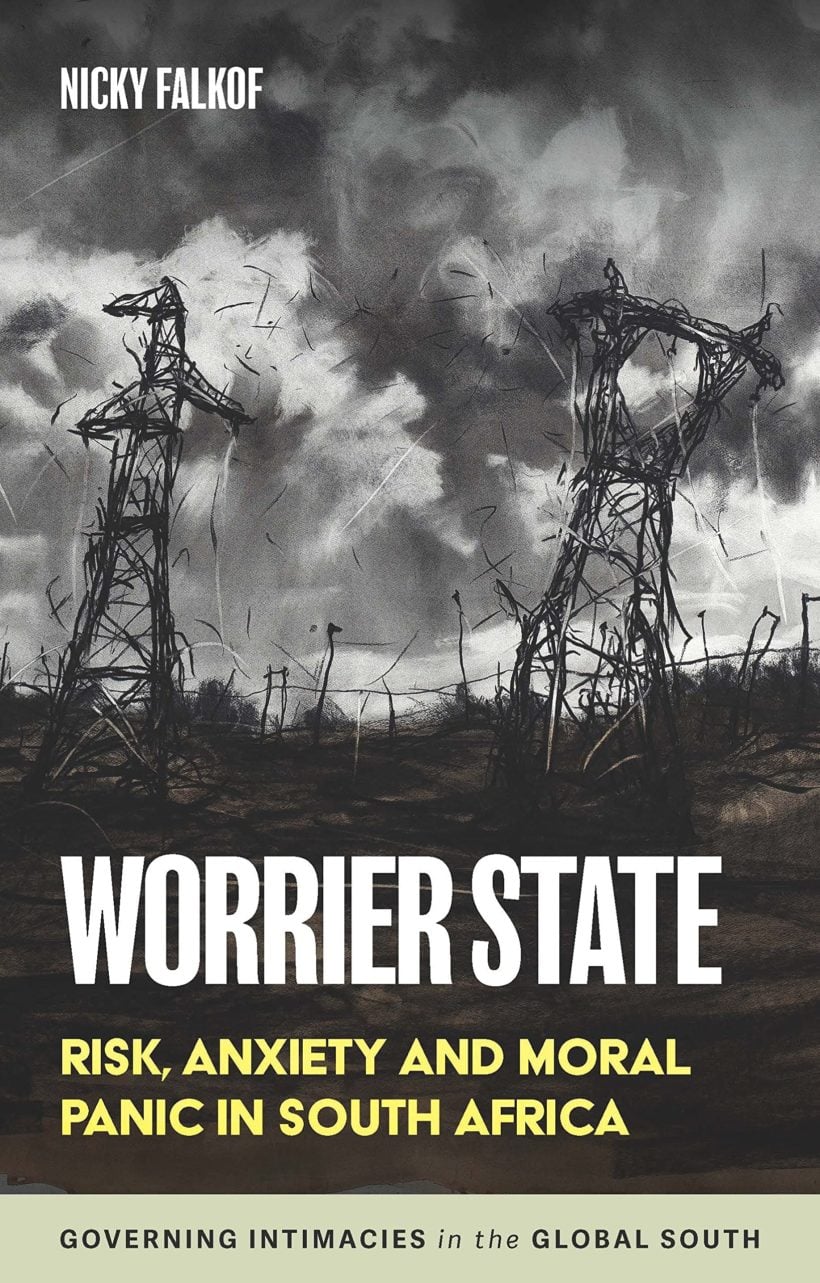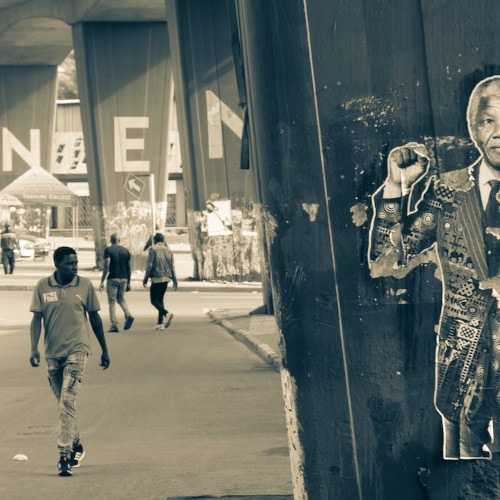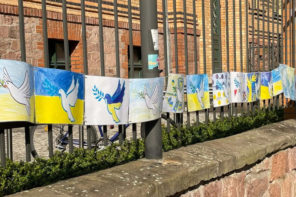Falkof, Nicky (2022): Worrier State. Risk, anxiety and moral panic in South Africa. Manchester: Manchester University Press.
South Africa 
With her new book Worrier State. Risk, anxiety and moral panic in South Africa, Nicky Falkof, associate professor of media studies at Johannesburg’s Wits University, gives a concise account of this while delivering an insightful inventory of South Africa’s contemporary emotional landscape that is fraught with the country’s painful history of violent entanglements of race, class, and gender.
Building on her previous work, for example on representations of satanism, murder, and whiteness (2016), Falkof traces different narratives of fear to account for how affective forces in public discourse are inseparably linked to negotiating questions of belonging and identity within South Africa’s new post-apartheid order. To this end, she treats circulating stories, rumours and urban myths as ‘ethnosociologies’ (Waters 1997) and – instead of only deconstructing them for the fictions they are – understands them as sites of communities’ “narrative world-making” (192) and, in a sense, as ordinary social theories that comment on some of the most pressing issues in the country today. As they are “implicated in the social, spatial, cultural and economic patterns that structure South Africa in multiple ways” (28), the author demonstrates how each of such stories evokes symbolism, actors, and antagonisms that are specific to certain publics. Thus, Falkof argues, fear is both experience and practice, people actively partake in discourses of fear “with agency and impact” not only by sharing them but through the way they tell them as well: “[w]e share these stories by choice and often exaggerate them in the telling. We use them to encode diffuse moral messaging […]” (13).
Indeed, South Africa is a striking example of a Global South country where ‘cultures of fear’ are not only nurtured “by politicians and media for strategic reasons” but also resonate with immediate, real life threat.
The book exemplifies four different cases of such public responses to instances of violence and crime and relates them to the local conditions of perceived risks and insecurity they are embedded in. These cases are framed by a prefixed theoretical discussion of which bodies of literature on affect and emotions Falkof’s work links to, and a strong conclusion on the state of emotions in South Africa. Therein, it is argued, that although fear being a significant symptom to what Zygmunt Bauman called ‘liquid modernity’ on a global scale, as a response to the insecurity of ever-changing political and economic structures, it is very well worth taking a look at how local specificities of this phenomenon materialise in the South African context (10-11). Indeed, South Africa is a striking example of a Global South country where ‘cultures of fear’ are not only nurtured “by politicians and media for strategic reasons” but also resonate with immediate, real life threats (19). This makes South Africa a productive case for theoretical knowledge production on such phenomena rather than a mere instance of empirical variation, a “derivate” or “mimesis” of Northern occurrences (7).
The first of Falkof’s examples deals with the ludicrous myth of a ‘white genocide’ in South Africa: congenial to studies about narratives of white supremacy groups and the far right in Europe or the USA, she explains how white Afrikaner interest groups act as “moral entrepreneurs” (26) capitalizing on this fiction. To those who buy into this conspiracy theory, a selective perception of violent robberies occurring at remote, white-owned farmlands as revanchist hate-crimes – although clearly blown out of proportion and ignorant to the circumstances of these instances as well as to the daily level of violence non-white people endure throughout the country – resonates with a feeling of general insecurity stemming from high crime levels as well as the loss of privileges for example by Black Economic Empowerment Programmes (BEE) after liberation. The term ‘reversed apartheid’ is in fact on the tip of the tongue of many white South Africans, irrespectively of how they position themselves politically, as probably most who are familiar with this specific South African context might have experienced. Against the background of an accumulation of several of the above-mentioned crises, and behind the ‘safe’ walls of fortified middle-class homes, it is easy to sense people’s growing unease and resentments. Their neurotic anticipation of immanent disaster is inscribed into ‘white talk’ (Steyn 2005) at dinner parties, Whatsapp-groups or at school gates, and it is not uncommon to hear it merge into restorative dismissal of the democratic project since 1994. Johannesburg’s characteristic urban anxiety (Falkof and van Staden 2020) and the defence of white entitlement are some of the main reasons for such protruding fears among the white population.
A particular strength of this book in this regard is Falkof’s status as an insider to this ‘world’. Identifying as a white resident of the neighbourhood herself, she reflects on a suspenseful ambivalence: while unavoidably being complicit in the production of difference in this locality by enjoying the animosities of white middle-class positionality, it also equips her with the necessary privilege to access white spaces and echo-chambers in order to develop critical accounts.
Suitably, another chapter of the book deals with rather moderate manifestations of such motives and dissects identity constructions through the online discourses of an affluent suburban neighbourhood in Johannesburg. The themes of online conversations among residents in a Facebook group disclose the precarious base of whiteness in the post-apartheid society as they revolve around a paradoxical undertaking. On the one hand, residents eagerly perform their compliance with post-apartheid’s prescribed “hegemony of liberal whiteness” (154) by overemphasizing acts of charity and subscription to the desegregation of living environments after the end of apartheid law. On the other hand, residents’ recurring complaints about noisy clubbers from other parts of the town, homeless people and alleged criminals and drug users are strikingly directed against the usual suspects. Fear of crime and the feeling of danger in white talk, Falkof argues, continue to be associated with the male Black body (153), reminding of apartheid times paranoia of the ‘swart gevaar’ (the ‘black danger’) and are hence articulated in fantasies of purity and exclusion from the local community. While property ownership and manifestations of class distinctions play a role in this, proxy discussions on the “neighbourhood character, about appropriate behaviour, about authenticity and origins” (115) clearly expose the persistent symbolic order of apartheid’s social and spatial engineering and thwarts the neighbourhood’s self-imagination as an open-minded, bohemian, and diverse residential area (155).
A particular strength of this book in this regard is Falkof’s status as an insider to this ‘world’. Identifying as a white resident of the neighbourhood herself, she reflects on a suspenseful ambivalence: while unavoidably being complicit in the production of difference in this locality by enjoying the animosities of white middle-class positionality, it also equips her with the necessary privilege to access white spaces and echo-chambers in order to develop critical accounts.
Fear of crime and violence, however, is not exclusive to white and/or affluent communities, as a large corpus of literature from urban studies covering fear of the privileged, for example by highlighting their “architecture of fear” (Lemanski 2004), critiques of gated communities and affluent segregation suggests (see e.g. Caldeira 1996; 2001). Highlighting and illustrating this fact is another merit of this book. This representational bias applies to popular and media discourses on townships and informal housing spaces in South Africa as well. Apart from Soweto, the country’s biggest conglomeration of townships that became a tourist hotspot covered with national heritage sites, other places like Alexandra, considered as spaces of poverty, illegality and danger, still owe to be represented appropriately in all their innovations and contradictions, multiple social, economic, and cultural realities. Falkof, on the contrary, works out how for example economic stratification and relating consumption and aspirational consumerism, just as fear of being expropriated from one’s valuable possessions, are as much part of normality here as elsewhere. According to stories that circulated a few years ago in Alexandra, an ominous syndicate of Nigerian drug dealers were incriminated with violently robbing expensive flatscreen TV sets to ‘harvest’ the magnesium oxide they contain, in order produce a common street drug. Taking example of this local rumour, the author situates these narratives within histories of racialised consumption, police corruption, morality and enviousness, that are also linked to the demonization of drug addiction and xenophobic sentiments against African migrants. The chapter can be read as a counterpoint to the two chapters on (white) suburban anxiety I described above, which enables us to chart South Africa’s emotional landscape more comprehensively.
Thereby it applies beyond the South African context: at times when coming climatic upheavals, tirelessly evoked ‘culture clashes’, predictions of infrastructural crises and the shortage of public goods ignite anxieties worldwide, this book is an important reminder
As Falkof emphasises, the narrative function of myths is to enable public disengagement with the root causes of the problems they imply. This meta-interpretation is applied for another chapter discussing media representations of the murder of a young woman at the margins of Johannesburg’s township periphery. Falkof argues that dominant representations of the murder as an occult, Satanist ritual crime is symptomatic of the reluctance of the South African (media) public to acknowledge the endemic nature of gender-based violence (83). The author situates this and a tragically long list of other instances within a greater analysis of the functional role these constructions of exceptionality have in popular discourses. Referencing Baumann’s theory of modernity again, she writes: “the category of evil exists to help us explain the inexplicable […] But the category of evil can also allow us to make things inexplicable, thus avoiding the need for closer examination. Discursively constructing certain types of acts simply as ‘evil’ (specifically, in these cases, as satanic) can free us from the need to consider them more carefully as a part and consequence of social, political, historical and economic structures” (81-82, italics in the original).
Taken together, the four chapters offer a multifaceted, sensitive, and inspiring analysis of the socio-cultural foundation of feelings, and are a strong example of how social media platforms as well as mass media do amplify these cultural articulations of affect. Thereby it applies beyond the South African context: at times when coming climatic upheavals, tirelessly evoked ‘culture clashes’, predictions of infrastructural crises and the shortage of public goods ignite anxieties worldwide, this book is an important reminder. Not only of how our attitudes and reactions to that are entangled to our troubled collective pasts and determined by contemporary economic and social positionalities. But also for how those anxieties become very dangerous vehicles for political mobilization, for example when seeking comfort and relief from reactionary, authoritarian forces and their political projects.
For everybody interested in the South African context, it is a must-read. But due to the author’s accessible and pointed style, Worrier State is also highly recommendable to readers across various disciplines, from political anthropology or social psychology to urban studies, for all interested in affect and phenomenology, the experience of postcolonial urbanity, intersectional feminist approaches and critical race theory.
References
Ahmed, Sara (2004): The Cultural Politics of Emotions. New York: Routledge.
Caldeira, Teresa (2001): City of Walls. Crime, Segregation, and Citizenship in Sao Pãolo. Oakland, CA: University of California Press.
Caldeira, Teresa (1996): Fortified enclaves: The new urban segregation, Public Culture 8(2): 303-328.
Clough, Patricia and John Halley (eds) (2007): The Affective Turn: Theorizing the Social. Durham, NC: Duke University Press.
Falkof, Nicky and Cobus van Staden (eds) (2020): Anxious Joburg. The Inner Lives of a Global South City. Johannesburg: Wits University Press.
Falkof, Nicky (2016): The end of Whiteness. Stanism and Family Murder in Late Apartheid South Africa. Johannesburg: Jacana Press.
Lemanski, Charlotte (2004): A New Apartheid? The Spatial Implications of Fear of Crime in Cape Town, South Africa. Environment and Urbanization, 16 (2), 101–112.
Steyn, Melissa (2005): White Talk: White South Africans and the Management of Diasporic Whiteness. In: A.J. López, ed. Postcolonial Whiteness: A Critical Reader on Race and Empire. Albany, NY: State University of New York Press, 119–136.
Waters, Anita (1997): Conspiracy Theories as Ethnosociologies: Explanation and Intention in African American Political Culture. Journal of Black Studies, 28 (1), 112–125.
Photo by Gregory Fullard on Unsplash








